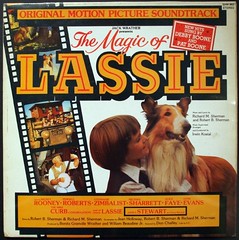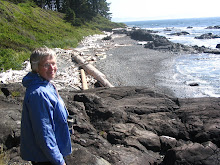In the 1960's, Sylvia set up the first school library in Saskatoon at Brunskill School. Before Sylvia was married, she worked in one-room rural schools. Each school had a few shelves of books which had been donated by community members. When Sylvia moved with her family to the city, she was disappointed that the schools she taught in had no school libraries. She scrounged around and badgered people and through perseverance, determination and lots of inspiration, set up a school library. Sylvia told me tha
Image by anyjazz65  via Flickr
via Flickr
This entire topic of virtual libraries has baffled and bamboozled me. I am really confused right now. Some virtual libraries that I have visited look more like a collection of websites and resources which are situated at a different URL location. (WWW Virtual Library) Some virtual libraries are more self-contained, providing many resources at their own URL locations. (Kids place at the Kentucky Virtual Library) Some are attractive and user-friendly. Some are downright boring and unappealing even though they may get the job done. (Bartleby) Some virtual libraries actually have e-books for students and parents to read. (International Children's Digital Library) My misconception when I started this learning was that all virtual libraries would contain e-books.
How have libraries evolved from that shelf of books in a forgotten room in a school to all of this online knowledge at our fingertips? How are virtual libraries and physical libraries the same and different? As I read through all of the Trailfire information (which by the way was an incredible valuable resource on this topic), I created a Venn Diagram on paper for myself. (Did you know that at the Kids place at the Kentucky Virtual Library as students follow the research trail, they can click on a printable version of a Venn diagram.) There are so many similarities between physical and virtual library collections. Both are organized collections created with a community of patrons in mind. They provide a range of resources--often these resources are expensive and valuable information resources which could not be accessed easily by an individual lea
 Image via Wikipedia
Image via Wikipedia
There are many differences between these two libraries. Virtual is located online at a URL. Physical libraries are located at a physical address which could be found on Google Earth. Physical are touchable while virtual are in the computer cloud. Physical libraries can be accessed by driving or walking to them.Virtual libraries can be accessed by computers with internet access. (This is where the digital divide comes in--when those without computers have no way to get the information. As well, there may be those with computers who do not know how to get at all the rich information resources on the internet. Gunn [2002] calls this the second digital divide.)
Physical libraries have a more difficult time staying up-to-date and current. Even when they know of new books, it takes months to bring the book in, catalogue it, and get it on the shelf. There may be long waiting lists of people who want to read the book before it physically reaches the library. (The Saskatoon Public Library has created something called Hot Titles for those who want those Hot books more quickly. In each branch, there is a display of new release
 John Grisham via last.fm
John Grisham via last.fm
Hybrid libraries need to provide 1) information access, 2) teaching and learning assistance 3) books and reading 4) interactivity and collaboration. Virtual libraries may provide some or all of these as well. However, most virtual libraries that I visited did not cover all of these bases.
All libraries need people to make them work. In Australia they have courses in ho
![]() Image via Wikipedia
Image via Wikipedia
As I think about virtual libraries, there are many wonderful possibilities for their use. However, there are also some issues. Many virtual libraries are created for a community of learners which may operate in a closed, password-protected venue. The Kentucky Virtual Library was one of the recommended virtual libraries. I could get into the elementary page but the middle school, high school, and university resources were password protected. As mentioned earlier, there is a digital divide which separates potential patrons from the virtual library if they have no computer or internet access. For those is rural areas with dial-up internet, this would also be an issue. The second digital divide would mean it is lack of knowledge about how to access sites and resources which would keep some patrons from available resources. I also know that getting sidetracked is very easy on the internet. In a physical library, there are only so many books at your fingertips on elephants. However, in a virtual library, one could research and learn about the elephant for days. This brings us to the issue raised by Gunn (2002) of "enough"- how much information is enough. She says this is "an important idea in an environment of information abundance". Usually when I research with print resources, I reach the point of "enough" when I am starting to read the same information over again with little new knowledge. I think we would need to teach students to know what is "enough" in an online environment in which there is always one more site and one more fact to garner your attention. (Possibly this whole concept of "enough" has eluded me on this quest for knowledge about virtual libraries. I have pages of notes in black ink as well as three pages of typing in my google document.)
Moving on to another difficulty with virtual libraries--in most of them, you need to know how to read. Even in the excellent e-book site (International Children's Digital Library) one still needs to know how to read to navigate the site, select the books, and then read the books. I did come across the Awesome Talking Library which allows one to select online text. Then the text will be read aloud for the patron. This process required downloading tools which they said would take one hour so I did not try it. In this situation, a patron would still need to be a reader in order to select the text. However, maybe a teacher could select the text for a student with visual impairments. Another (and maybe the largest) issue for virtual libraries is keeping the site current and up-to-date. In the first Trailfire article (Gunn, 2002), she gave links to great virtual libraries. Of the K to 12 Virtual Libraries which were recommended in 2002, only one link still worked. I did not explore further, it may be that the libraries still exist but at a different URL. However, this speaks to the importance of the human element in creating and maintaining virtual libraries. It's strange to think that something non-human is so dependent on the human.
One last difficulty that I have encountered with virtual libraries is reading journal articles in two column formats online. In an earlier blended class (part face-to-face and part online), students were required to post a refereed journal article along with their critique of that article online for their classmates to access. It may be that my computer screen is too small but it drove me crazy trying to read those two column journal articles. I was always scrolling up an down. I think in an online format, it is easier to read one column text.
How have I used virtual libraries? During the learning for this post, I tried out Bartleby.com to try to find the source of a quote. It is from a poem that I memorized in school. I only remember a few phrases: "fold their tents" "silently steal away" "cares of the day". Using Bartleby's search tools, I found out that the poem was written by Henry Wadsworth Longfellow. The title of the poem is Day is Done. Using that information, I found the poem itself on a different website. I have also used my university library site most often in its virtual entity. I search online databases and journal articles. I have learned how to safe all my references in RefWorks. While reading for this post, I came across a way to move directly from Google Scholar to my University of Saskatchewan library. Murdoch University in Australia provided this information for their students. I tried it with my university and it worked.
How to set up library links in Google Scholar
- Go to Google Scholar and click Scholar Preferences.
- In the Library Links search box search for “murdoch”.
- Tick the checkbox for the option Murdoch, Portal, Library, Australia - Find it@Murdoch
- Click Save Preference
- You will need to set this up each time you use a different computer. Google Scholar does not “remember” you.
- Now search for something in Google Scholar, and look for the Find it@Murdoch links in your search results. This is what you should see:

How are some ways students will use virtual libraries? Some people interviewed about their research habits on a video I watched last night, said that they always start out with Google. As someone else stated, "Google doesn't create information. It is a gateway for information provided by others." So, in one way, isn't Google itself, a giant virtual library. Of course, the resources provided there-in are categorized by popularity and by the random nature of the words one inputs for the search. However, since students will likely begin with Google, they need to be taught skills for doing Google searches. This is where folksonomies and taxonomies come in. Google is mainly organized by taxonomies (hierarchical series of tags). Human
 Image by Jacob Whittaker via Flickr
Image by Jacob Whittaker via Flickr
Joyce Valenza (n.d.) believes that collaboration is very important for library patrons. Students need to find a place in a virtual library. Students could create books reviews, photo collections, podcasts, suggest websites for inclusion in pathfinder pages, and post art or writing. Joyce says that "Students who collaborate and participate in building spaces, both physical and virtual, are likely to be more comfortable living in them". (Valenza, n.d.) When I think about my Caswell Homes project (the one I talked about in my podcast blog), it would have been wonderful for students to post their work (database of homeowners and occupation of each, interview information, project arising from the house) online so that homeowners and other interested parties could have collaborated with them in a virtual manner. When we met with homeowners, they would often correct information or give additional information. They would lend us artifacts or photographs. How wonderful it would have been to have created an online version of everything? Instead there are paper versions which are accessible only at the Public Library's Local History Room. Oh, the possibilities if I were to do that project over again.
One way of using virtual libraries which I encountered and attempted to use was A Day in the Clouds contest. It took place in June of 2009. People flew together and tried to use
 Image by kevindooley via Flickr
Image by kevindooley via Flickr
Just a few more random thoughts before I wing this on its way into cyberspace. Several different visuals were given of a library by several people. One person saw the library as a beehive filled with community, excitement about discovery, food, and comfy chairs. (I guess that could apply to both physical and virtual libraries. I often eat [chocolate-covered Dad's cookies fuel my brain] and have a super comfortable office chair at my computer.) Another person (Salvador Avila) saw the library as a "big hard-drive beaming info out to the community". Another person saw the library as a conference center. (I guess that is why virtual libraries need to have an interactive element--a blog, Twitter account, way for patrons to suggest books or resources, ways for resources to be evaluated and reviewed by patrons, or an Ask the Librarian feature.) Even the Library of Congress now has many online resources and a Twitter account.
As I mentioned earlier, I believe that teacher-librarians will need to maintain hybrid library collections filled with current information resources. These libraries will be built and maintained by staff and patrons together. I experienced this coming together of physical and virtual libraries recently as I searched for the source of a quote. I had memorized this quote back in 1974 when I was struck by the idea of enthusiasm. It is the quote I used in a previous blog about needing to hemorrhage if you want others to bleed. Since I become very enthusiastic about things (hence the title Blustery Bandwagon for my blog), this quote has become a touchstone for me. However, when I wanted to use it in my post, I knew I needed an author and book along with a page number. I suspected the book was on the book shelf behind me. However, I couldn't remember the title of the book. I scanned the book shelf. No luck. I remembered the author's name. I went to Google and typed it in. "Howard Hendricks" I saw a site that named the books he has written. I found the name of the book (Say It With Love). I returned to the shelf and there it was. I found the quote so I could quote it word for word. Virtual and physical library came together to assist and support my learning process.
 Image by Jeffrey Guterman via Flickr
Image by Jeffrey Guterman via Flickr
The bottom line in looking at virtual libraries is that traditionally libraries have been free and allowed democratic access to knowledge. Anyone was allowed to enter. You needed a library card in order to take items out of the library. However, you could sit and read the newspaper, a magazine, or book for free. Hopefully, virtual libraries can continue the great traditions of physical libraries while staying open 24/7 and feeding people's thirst for knowledge anytime and anywhere.
References:
Greenhill, K. (n.d.) Librarians' work with Second Life. Video online at: http://www.viddler.com/explore/sirexkat/videos/1/#
Gunn, H. (2002). Virtual libraries supporting student learning. Online at http://www.accesswave.ca/~hgunn/special/papers/virlib/index.html
Valenza, J. (n.d.). Joyce Valenza virtual libraries slideshare show. Online at :
http://www.slideshare.net/joycevalenza/virtual-libraries-presentation-713259
![Reblog this post [with Zemanta]](http://img.zemanta.com/reblog_e.png?x-id=4366ed05-0a59-4c60-b936-5c89b9bc5e53)





Ruth, when I began my exploration of virtual libraries I felt just as confused as you. There are purported differenes between virtul, digitized, and online libraries. I found that in many cases, I needed a userid and password to access any or most of the data. I like the no-nonsense distinctions you have made.
ReplyDeleteI also enjoyed your accolades for Sylvia Birnie.
Lori
Hi Ruth,
ReplyDeleteYou nicely trace the beginnings of school libraries and the evolution to where we are today. Starting with a personal story about Sylvia had me hooked from the beginning!
Thanks,
~:) Heather
Hi Ruth,
ReplyDeleteI appreciate the comparisons you've made between the types of libraries as well as the reference to "free & democratic access for all". I'm hoping that will be the case for virtual libraries as it has been with physical ones. I, too, have run into trouble trying to access certain articles without having the necessary credentials - so frustrating when you know it's right there!!!!
Well done,
Carol